The Run of Their Lives: The Ottawa Marathon
How a small Ottawa marathon became the biggest race weekend in the country.
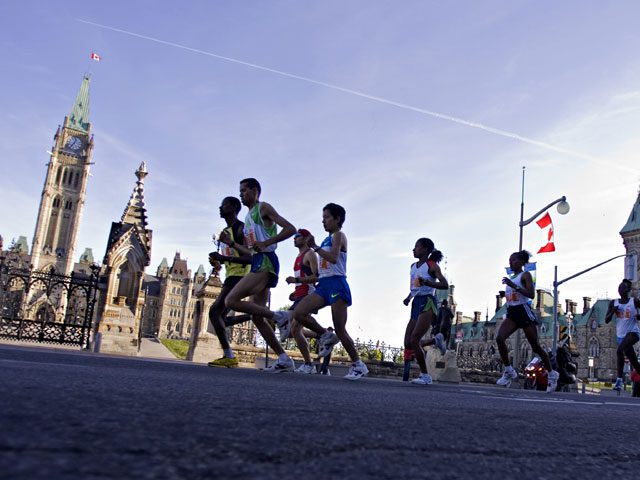

By Theresa Wallace
The 159 runners had hand-drawn numbers on homemade cloth bibs pinned to their T-shirts. They stood at the start line at Carleton University in Ottawa listening to local marathoner and orthopedic surgeon Don Johnston’s advice on running in hot weather. It was Sunday, May 25, 1975. The gun sounded and they surged forward into Canadian running history.
This small marathon has evolved into the biggest race in the country, a weekend of events with close to 44,000 runners. In 1975, there were three women running; now more than half of all Ottawa Race Weekend participants are female. In addition to the marathon, there’s a wheelchair marathon, a half-marathon, a 10k, 5k, a 2k family run and a huge celebration of running at the race expo. “It’s been a wonderful sociological evolution,” observes Howard Cohen, who has run all 39 Ottawa marathons. “Race weekend now has something for everyone.”
Some things haven’t changed. “The atmosphere for that first race was upbeat and there was a community feel to it,” recalls the women’s winner that first year, Eleanor Thomas. “The support on the course was fabulous, just as it is today.”
The marathon was started because Ottawa runners kept bumping into each other at out-of-town races and decided they needed their own marathon. The volunteer race committee was made up mostly of runners who would jump into the field on race day morning when their volunteer duties wrapped up.
After that first race, organizers began offering monthly running clinics. Running coach Ken Parker, one of the founders and main organizers of the race in its early years, says they brought in experts such as Arthur Lydiard, George Sheehan and exercise physiologist David Costill to help Ottawa runners learn how to conquer the marathon. In its second year, the race served as the Olympic trials. In 1978, the finish line photo of PowerBar inventor Brian Maxwell beating Paul Bannon by a single stride was picked up by international media.
Hal Higdon of Runner’s World raced in 1981 and reported in the magazine that Ottawa was a runner’s paradise. Astonishingly, 630 of the 3,478 finishers that year (see sidebar p.56) completed the course in under three hours.
Wheelchair competitors began entering the marathon in the late 1970s and organizers presented an official trophy to wheelchair winners beginning in 1983. Rick Hansen won that year. “What sticks out in my mind from the race were the new areas of breakthroughs of inclusion,” Hansen recalls. “To come to a Canadian city that was inclusive was fantastic.”
As the race got bigger, its reach into the life of the city grew and so did the local legends. In 1982, local runner Paul Bush passed out from extreme heat exhaustion within sight of the finish and was rushed to the hospital and into intensive care. Organizers restaged the finish line a few weeks later so Bush could complete his marathon. In 1983, David Blaikie, author of Boston: The Canadian Story, started the marathon route in pouring rain and darkness at 3:30 a.m. on race day and ran the whole route solo, finishing in time to catch the press bus and cover the real event.
In 1986, after the race was cancelled for more than a week due to lack of sponsorship but then rescued by a local business, organizers added a 10k race to bolster registrations. Parker had stayed on as one of the main organizers until then, but after that the race director changed every year or two. By 1995, the 10k race was still growing but the marathon was losing its lustre. Entries that year had fallen to 629 runners. When Jim Robinson took over as race director in 1996, he acted quickly to rejuvenate the event, introducing rollerblade races to increase revenue and entertain spectators. Then in 1998, he added a half-marathon and a 5k run, assisted by the innovations of local timing company Sportstats, now the largest timing company in North America, which that year made Ottawa the first running race in the country to be chip-timed. “I wanted to grow our marathon, and by adding those other races, I was adding revenue to the marathon,” Robinson explains.
Robinson set up booths at other Canadian marathons to publicize the race weekend. He also travelled to the Boston and London marathons and other big races to learn how to put on a good expo. “We saw the expo as a revenue generator, so we built ours slowly and carefully.” Many runners say the expo, now held in the Ottawa Convention Centre, is the best in Canada.
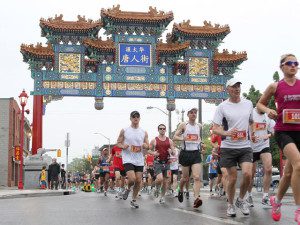
With Robinson at the helm, Ottawa Race Weekend grew from 5,000 runners in 1997 to over 42,000 in 2012 with four full-time employees and a budget in the millions. Starting in its second year, the marathon was held for decades on Mother’s Day, but Robinson’s team changed the date to the weekend in May following the Victoria Day long weekend. They also tinkered with the course, developing the marathon route into what is now an expansive scenic tour of the National Capital Region.
Olympian John Halvorsen took over from Robinson in February. Halvorsen is well-acquainted with race weekend – he won the 10k in 28:12 in 1988, setting a course record that stood until 2009. He’s volunteered with the race for more than a dozen years, most recently as chair of its board of directors. Early on, Halvorsen developed a business plan to help chart the race’s future, emphasizing mass participation, international credibility and community.
More than half of all race weekend participants are now from outside the National Capital Region. Noel Buckley, ceo of Ottawa Tourism, says Ottawa Race Weekend has played a huge role in branding Ottawa as a great city. “It demonstrates Ottawa is a green city, an outdoor city, a fun, active urban place,” Buckley says. “Plus the route is such a big draw, with the Parliament Buildings and the Rideau Canal, a unesco World Heritage Site.”
Halvorsen says he’s trying to make next year’s 40th anniversary a special experience for runners. He’d like to grow the marathon, the marquee event of the weekend, to 10,000 runners. (This year there were 6,200 marathon entries.) He’s also looking toward Canada’s sesquicentennial in 2017. “It will be a big year of celebrating here, and we’d like to be part of that.”
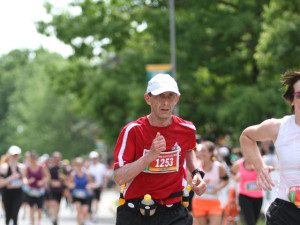
The Runners
Howard Cohen has done every Ottawa marathon
Family physician Howard Cohen started out his Ottawa Marathon career in 1975 with a petty theft. “Coming back along the canal, we were getting dehydrated. We saw one of those ice cream vendors on bicycles and rather than drinking out of the canal we decided to relieve him of his ice cream. We had no money, but we pleaded our case and the poor fellow had mercy on us.”
The 25-year-old resident at the Ottawa Civic Hospital finished around 3:30. Then he and the many friends he’d made during that first race came back the next year much more prepared. “We realized we could have run faster with better pacing, better shoes and adequate fluids. We got the marathon bug.”
Cohen’s best time in the 39 consecutive years he has run the race was 2:43:57. His worst was in 1994 when he’d torn his hamstring during the winter in a cross-country ski race, and had to use a cane. Past the five-hour mark, the hobbling Cohen noticed volunteers at the last water station were packing up and enjoying pizza and beer. “I sat down and asked for some. They kept the finish line open for me, but after that year, organizers set a time limit. I might have been responsible for that. But the pizza and beer sure tasted good.”
Cohen says his wife Marlene has participated in the Ottawa Race Weekend most years, as have their two daughters. “Typically they’d enter the 10K together on the Saturday night and I would cheer them on. The next day they’d cheer me on in the marathon. So race weekend is really a family event for us, just as it is for many other families.” (Cohen’s daughter Tamara did the marathon this year in 4:14:27, beating her dad by 13 minutes.)
Cohen, 63, admits he’s still doing the Ottawa Marathon because John Stoddart and Bill Williams, both in their 70s, have also completed all 39 Ottawa Marathons and aren’t ready to give up. (See ‘Ottawa Marathon Results Then and Now’ on p.56.) Cohen is their family physician and the three have agreed they’ll all quit together. “We work hard but finish in one piece. It’s humbling to be slowing down and competing against yourself rather than others, but healthy too.”
Every Ottawa Marathon has a slightly different flavour, he says. “There will be a new route, or new folks you meet out on the course, or interesting weather. It is never mundane. Every year, if you have an open mind, the event is there to challenge you but also to greet you.” He’s grateful to the organizers. “So many capable people have worked behind the scenes to make this event what it is today. I’m the lucky one – I just run the damn thing.”
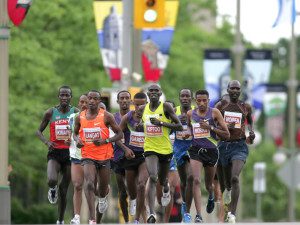
The Elites
Supporting our best
There’s a strong connection between the elite Africans, the best Canadians, and the recreational athletes who come together to run in Ottawa on race weekend, and it’s got to do with the bottom line.
Since his position was created in 2001, Manny Rodrigues, race weekend elite co-ordinator, has been working to improve the quality of the elite field. As a result, the Ottawa Marathon and 10K are now designated by the IAAF as silver-label events. “There are extra subtleties,” explains Rodrigues, “but to put it simply, having the elites in these races means we maintain our silver IAAF status, which helps us attract major sponsors, which in turn enables us to keep putting on the race weekend for everyone.” Rodrigues says the annual budget for elite racers is currently into the six figures.
“It’s because they put on this great race that attracts many thousands of recreational runners that Ottawa Race Weekend organizers are able to fund Canada’s elites,” says Thelma Wright, national distance running coach with Athletics Canada. Beginning in 2009, the Tamarack Ottawa Race Weekend (along with the Scotiabank Toronto Waterfront Marathon) has partnered with Athletics Canada to help fund Canada’s top marathoners’ participation in the world championships.
The Ottawa Marathon is the official Canadian marathon championship and Wright says race organizers do everything possible to make sure Canada’s top marathoners have as fast a race as possible. With over 100,000 spectators, Wright says the race weekend also gives Canadian elites the mental boost they need to take their performances to the next level.
Rob Watson, top Canadian at this year’s race, and also the first Canadian at the Boston Marathon in April, finished 10th overall in Ottawa with a time of 2:18:33. Watson’s longterm plan is to qualify for the 2016 Olympics and he says the Ottawa Race Weekend is an important part of this plan.
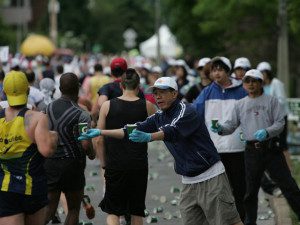
The Volunteers
World-Class help
From its beginnings, the Ottawa Marathon thrived and attracted Canada’s best runners because of its reputation for superb, professional organization. Those organizers were volunteers. By 1978, there were hundreds of them supporting a field of over 2,500 marathoners.
True to its deep-rooted volunteer tradition, the 2,000 volunteers who now work the Ottawa Race Weekend are good enough to take care of some of the world’s best runners.
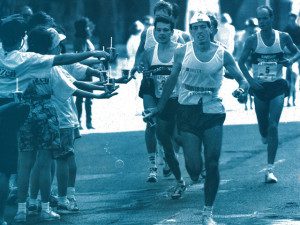
“Volunteers pick up the international elites at the airport,” Manny Rodrigues explains, “and I go through the regular race weekend water station co-ordinators to arrange for the elites’ water bottles to be placed and secured out on the course. They know exactly what to do.”
Former race director Jim Robinson says volunteer expertise has been crucial to the growth of the race. “Some water station volunteers back when I started 17 years ago are still out working the water stations and creating the party atmosphere that’s so important on race day,” he says. “For many years there’s been a whole family who helps set up the finish line – every year I’ve counted on them and every year they’ve come back. We’ve been very lucky with our volunteers.”
Debby Whately started volunteering 31 Ottawa marathons ago and has volunteered every year since then. She currently works as a trucker in charge of the Westboro section of the marathon route, getting out early in the morning to make sure all the barricades are in place and the route is clear of traffic, and then cleaning up and reopening the route to vehicle traffic after all the runners have passed. She says she comes back year after year because she loves cheering on the runners and considers it payback for all the volunteer support in her own athletic endeavours.
Whately believes effective pre-race advertising of road closures and the city’s great affection for the race make her job much easier. “I’m impressed with the patience of residents along the route who can’t get out of their driveways,” Whately notes. “A few complain, but most just grab their coffee, set up their lawn chairs, and cheer on the runners.”
Ottawa Marathon Results
Then and now
Year 1981 2013
Number of finishers 3,478 4,802
% female finishers 10 37
Overall mean time 3:26:15 3:58:02
Top Canadian 2:16:07 (1st) 2:18:33 (10th)
50th overall 2:34:24 2:44:11
100th 2:39:31 2:54:37
500th 2:56:37 3:16:49
1,000th 3:09:37 3:30:58
2,000th 3:31:36 3:50:56
3,000th 4:01:54 4:10:13
Runners sub 3 hours 630 161
John Stoddard 2:44:36 6:36:23
Bill Williams 2:48:33 6:18:02
Howard Cohen 2:55:17 4:27:36
(1981 info above is taken in part from a 2007 article posted by
Ottawa runner Dave Stewart on RunnersWeb.com a nd u sed h ere
courtesy of Stewart and Ken Parker, the site’s publishers.)


